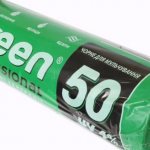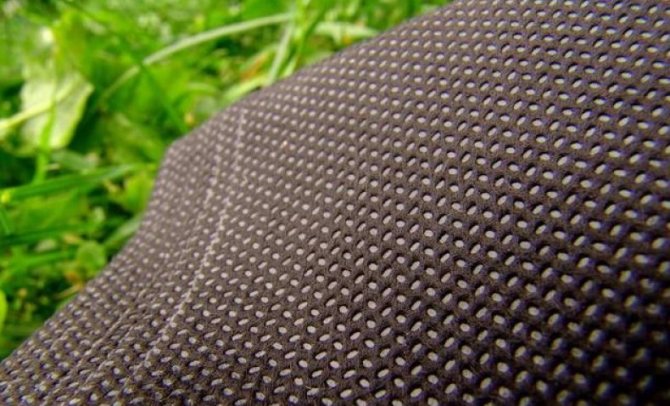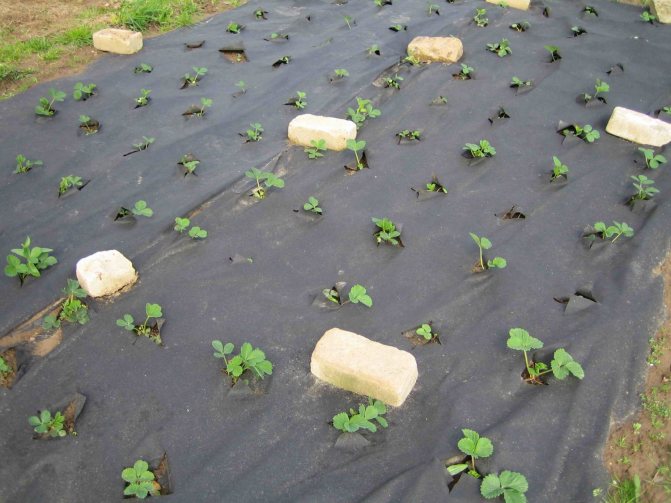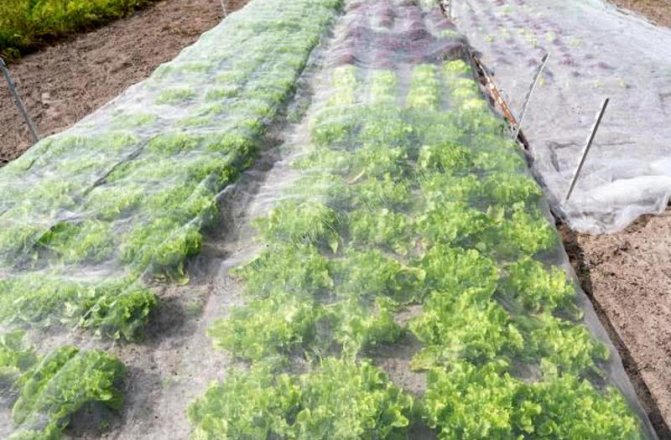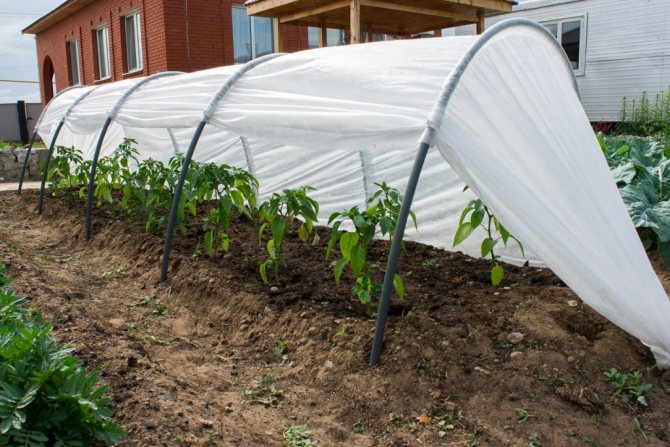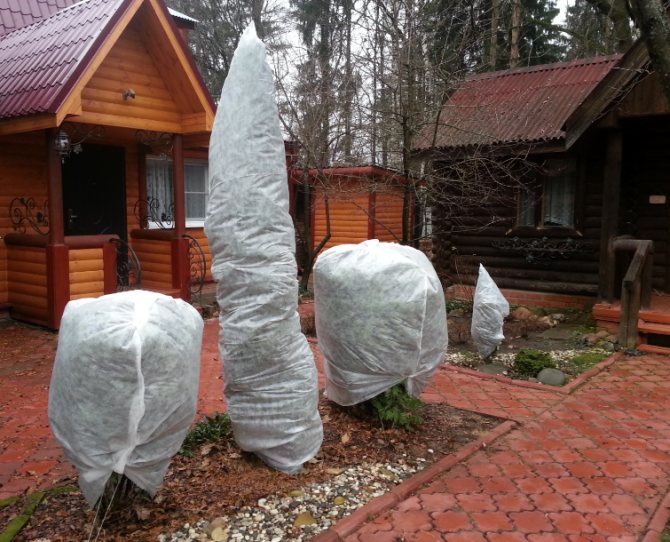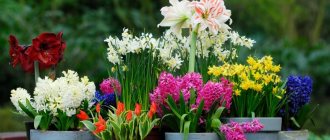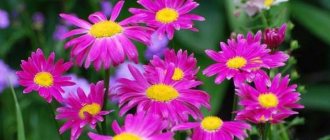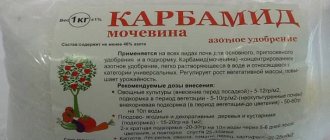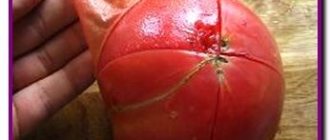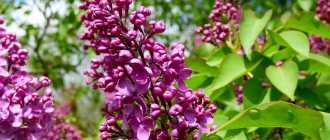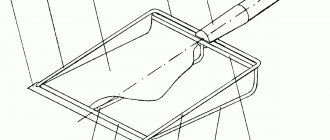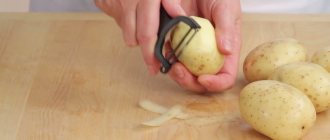Application at any time of the year
This environmentally friendly agrofibre can be effectively used on the site all year round.
Spring
In spring, thanks to its optimal density, spunbond protects plants from adverse weather conditions and sudden night frosts. At the same time, this material makes it possible to plant seedlings or start sowing ahead of schedule.
Protects spunbond young plants from birds, rodents, insects and other pests. In addition, even in arid regions, this material can be used to grow plants that cannot absorb moisture in the open field.
With the onset of summer, spunbond will serve as an excellent mulching material. At the same time, it will retain moisture and save the root system from overheating. Moreover, this agrofibre will slow down the growth of weeds and protect crops from dangerous pests.
In addition to textile material, organic elements are also used in mulching: compost, sawdust, hay and straw, peat, green manure, mowed grass, bark, rotted foliage, needles.
The use of spunbond when growing gooseberries, blackberries, strawberries, strawberries, currants will help protect these crops from various diseases (gray rot) arising from the contact of fruits with moist soil.
Fall
In the autumn period, spunbond does not lose its relevance. It can be used for:
- protection from wind, hail, frost and other adverse weather conditions;
- preservation of plant germination;
- prolongation of daylight hours and, consequently, the period of fruiting.
In addition, this material will serve as a kind of analogue of the snow cover in late autumn, protecting crops from low temperatures.
Find out more about such covering material as Agrospan.
In winter, spunbond will also serve you faithfully:
- will provide plants with protection from freezing (strawberries, strawberries, winter garlic, etc.);
- will replace snow with little snow in winter, and in a snowy season it will not break even under a thick layer of precipitation;
- protect plants from the formation of an ice crust after a thaw;
- will prevent the roots from sticking out.

Disadvantages and advantages of agrotextile
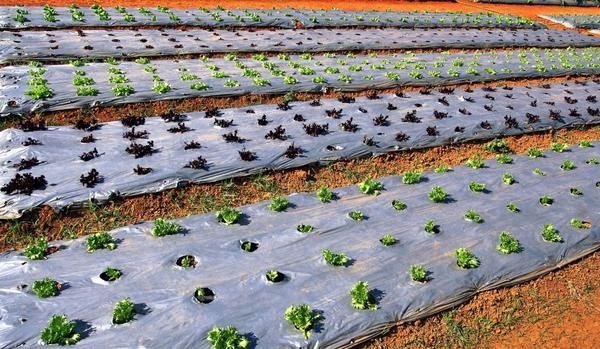

Agrotextile has advantages over film, polyethylene, tarpaulin and other materials
Agrotextile prices
Agrotextile
The most common, cheap substitute for covering material is polyethylene film... It is sold in any stores, but in terms of performance it is inferior to lutrasil and similar products. Polyethylene is short-lived, promotes the accumulation of condensate, is powerless against weeds, does not retain moisture in the soil. Compared to it, nonwovens have the following advantages:
- they are soft and light, due to which they do not injure plants;
- keep their shape well, that is, they can be used to equip greenhouses without additional supports;
- the fibers of the canvas allow air, light and moisture to pass through, and you can water or fertilize the plantings without removing the shelter;
- are resistant to ultraviolet radiation, protect plants from harmful UV exposure;
- nonwoven fabrics are harmless to human health, do not pollute the environment;
- prevent the germination of weeds, protect plantings from insects, birds and other pests;
- agrofiber is durable, resistant to mechanical damage, it can be glued, washed, sewn;
- has many varieties with different performance characteristics.
Disadvantages for covering non-woven fabrics Hardly ever... The only drawback is that it prevents insects from pollinating plants, but this applies to any materials used to protect plantings. In addition, when mulching the soil with material (planting seedlings directly under the shelter), access to the soil around the beds is significantly difficult - it will be extremely difficult to loosen or weed it.
Manufacturers
Spunbond is widely represented in our country today and its production is mastered by many companies.
The leading brands are:
- Lutrasil (Germany);
- Agril (France);
- Agrin (Ukraine);
- Agrotex (Russia);
- Plant-Protex (Poland).
As you can see, new engineering solutions can significantly simplify the work of an agricultural producer and facilitate the work of summer residents. Such an innovative material as spunbond will allow not only to get a good harvest in the current season, but also to maintain the germination of plants next year.
Covering plantings with lutrasil and useful tips
As we have already said, lutrasil can have different densities and, depending on it, one should choose one or another option for sheltering their plant crops. So, if the material with the minimum density is sufficient to cover the seedlings of thermophilic plants, then to cover the greenhouses with greenhouses, you need to choose a denser option.
It is very important to choose a covering material so that air can freely penetrate under it. And if there is the need for pollination of the garden, it can be removed for a while.
The service life of the coating also depends on its density. The denser the material, the longer it can be used. And remember that when using such a shelter, plants develop better and bear fruit earlier.
If you want to purchase lutrasil for your site, then take into account such helpful tips:
- before rolling out the coating, the soil must be slightly moistened;
- it is best to spread it first, and only then start planting plants, for this, in the required places, you need to make cuts in the form of crosses;
- sowing crops must be covered immediately after seed application. The material is fixed with an ordinary weight, sprinkled with earth or bent "ears" made of wire are pinned to the ground;
- with punctures, the tissue does not tear further than the puncture site;
- during the first watering, moisture may roll off and not immediately fall into the ground. But with subsequent watering, this will go much faster, so do not turn on a high pressure so that there are no large puddles.
What is spunbond: application and characteristics of the covering material
Over the past 10 years, at vegetable and horticultural seminars and forums, there has been an active discussion of the advantages and features of the use of the new covering material spunbond.
Now many summer residents are successfully using this material on their plots, but not everyone knows about the directions of its application. At the same time, the technology does not stand still, and manufacturers are constantly making adjustments to it, which makes it possible to expand the list of products and open up new opportunities for application.
Spunbond, lutrasil, agril, spantex, agrosuf, agrospan - what is it?
Surely many of you have come across these outlandish names. An experienced gardener immediately understands what is at stake, but for a beginner it is like the alphabet of a new, unexplored language. All of these are well-known trademarks, under which the material, which is extremely necessary in horticulture, is made, consisting of non-woven polypropylene fiber.
Covering material for beds
When I went to buy a non-woven polypropylene material for covering strawberries, I did not see the difference between the rolls, the consultant then also could not tell me what the fundamental difference is. When I brought home my purchase, it turned out that the material of the purchased density can be used to cover greenhouses in winter, but it is not very suitable for berries in the spring. Let's talk about the density of the nonwoven material.
What is spunbond and where can it be used?
To better understand what spunbond is, it is necessary to study the technology of its production. The product is obtained from a molten polymer, the fine fibers of which are caught in the air stream and placed in the web.
The result is a durable, wear-resistant and durable nonwoven material that has found wide application, including in agriculture. For long-term use of the polymer material under ultraviolet sun rays, the technology provides for the inclusion of stabilizers in the composition of the agrofibre melt.
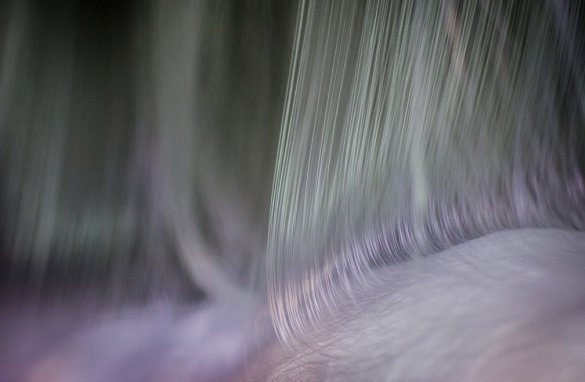

In horticulture and horticulture, agrofibre is used with a density of 17 to 60-80 g / m2, depending on the immediate purpose. Spunbond is used both in open and protected ground.
Conventionally, three main areas can be distinguished where the spunbond covering material can be used: accelerating the heating of the soil and obtaining earlier shoots, protecting the topsoil from drying out and saving on watering, protecting plants with low winter hardiness from severe frosts. However, the use of spunbond is not limited to this.
Agrotextile and agrofibre - what's the difference
The material does not contain toxic or chemically active components, therefore it is considered environmentally friendly. This is indicated by the area of application: spunbond is often used in furniture production and in the manufacture of personal care products.
Geotextiles can be woven and non-woven, but in general, they are made according to the above technology. This is why materials are often confused. In fact, geotextile is one of the varieties of spunbond, but it has a wider scope of application.
Spunbond properties and application features in different seasons
Before describing the effect of agrofibre on plant growth and yield formation, it is worth considering its main technical characteristics:
- good air permeability (the lower the density, the more intense the gas exchange);
- homogeneous structure (guarantee of uniform distribution of moisture and heat and maintenance of a constant microclimate);
- light transmission (may vary depending on the purpose);
- high thermal insulation properties (also directly dependent on density);
- low specific gravity, which does not exert pressure even on young shoots;
- high strength, resistance to abrasion and creasing (which makes the material practical and durable);
- resistance to adverse atmospheric factors (does not change its properties at temperatures from -55 to 100 ºC);
- not exposed to putrefactive bacteria and mold;
- inert to various chemical compounds (treatment with pesticides will not affect the state of the material in any way);
- is not toxic to plants and future crops.
The properties shown may vary slightly depending on the type and manufacturer of the nonwoven fabric.
Spunbond can be used at any time of the year. In the spring, it is used to speed up the heating of the beds in order to carry out earlier crops. At the same time, it protects the already appeared seedlings from low night temperatures and return frosts, serves as a shelter for seeds and young shoots from birds and rodents, retains moisture in the soil and slows down erosion processes, preventing the action of strong spring winds.
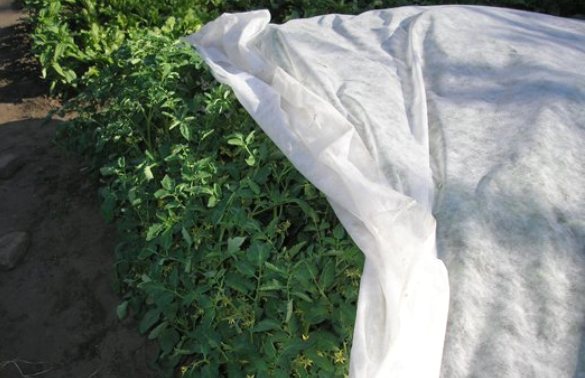

In addition, white spunbond with a density of 42 and 60 g / m2 can be used to cover frame beds, a greenhouse or a greenhouse. At the same time, the optimal level of illumination is ensured, there is no condensation and reliable protection against frost and cold showers with hail is established.
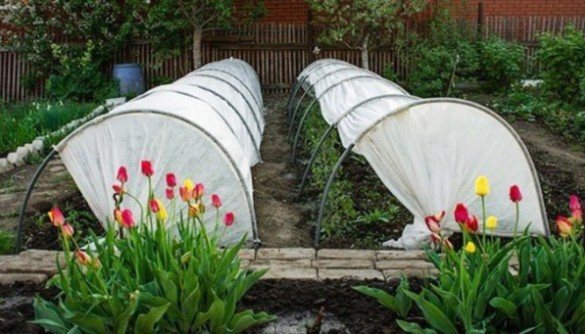

With the onset of summer, agrofibre serves as a reliable mulching material, retaining moisture, preventing overheating of the root system and slowing down the growth of weeds. In addition, spunbond is an obstacle for a number of dangerous pests (for example, slugs and bears).


The use of the material in horticulture (on plantations of strawberries, gooseberries, currants, blackberries) reduces the development of diseases caused by the contact of berries with moist soil. First of all, this applies to gray rot, the causative agent of which is found in any soil.


The use of spunbond in the fall can prolong the fruiting of many crops, protecting them from a sharp cold snap and a drop in night and day temperatures. Thus, it becomes possible to extend the growing season, which is especially important for the Far East and Siberia. Also, in autumn, agrofibre is effectively used to prepare plants wintering in the open field to lower temperatures.


Timely covering with non-woven material allows perennial plants to complete the transition to the stage of deep dormancy and serves as a reliable protection of the root system from the first frosts in the absence of snow cover.
In winter, spunbond protects podzimny crops, young seedlings of fruit and berry crops, transplanted ornamental plants from extreme weather factors: severe frosts, lack of snow, strong winds, the formation of an ice crust after a thaw, bulging of the root system.


Regardless of the season, agrofibre is used in greenhouse vegetable growing, allowing you to extend the turnover of vegetables. In addition, the beds covered with spunbond leave the fruits clean and beautiful, the development of fruit rot is excluded on tomatoes.
Lutrasil technique
This type of canvases is most often used for mulching and plant protection. But even in this case, there are certain nuances that must always be taken into account.
Features of mulching
The most durable, black material is used for mulching row spacings, paths and, of course, the plantings themselves. In springtime, the planting site is covered with lutrasil, making small cuts in different places. Later, strawberries, onions, tomatoes, peppers and cucumbers will be planted in them. In addition, these holes can also be used for watering. Lutrasil in this case is simply irreplaceable, since it prevents the accumulation of condensate, the formation of harmful dampness. The ground under such a canvas always remains loose, due to which it allows air and nutrients to pass through well.
In modern stores, you can buy two-color canvases. One side is white to prevent overheating of the root system. Separately, it is worth considering that if lutrasil was purchased exclusively for mulching, then it can be used for no more than three years.
Plant shelter rules
With the help of canvases, the density of which reaches 17 g / m², it is possible to shelter heat-loving plants from seasonal frosts. But the air temperature must be at least -3 ˚С. The denser options are suitable for providing shady cover.
Lutrasil with indicators of 60 and 40 is more expedient to use for arranging greenhouses and greenhouses. Plants that have been grown under such a cover begin to bear fruit much earlier.
In order for the removed canvas to be well stored, it must be rinsed with plain water, dried and removed to a dark place. If during operation it is heavily contaminated, then you can use a non-aggressive powder or ordinary laundry soap.
Types of spunbond
Of course, different types of covering material are used for various works, endowed with certain qualities.For agriculture, white, black and two-color spunbond of different densities are produced.
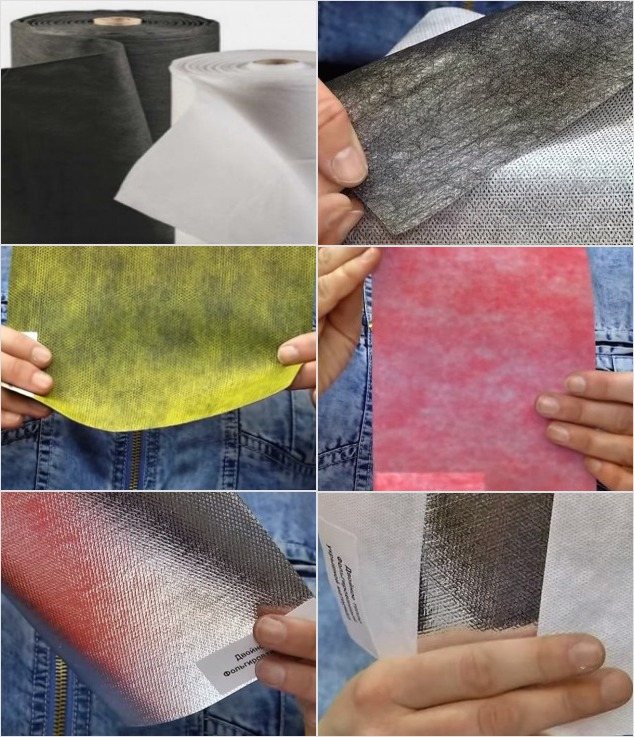

White transmits the sun's rays and plants under it develop successfully. Black, on the contrary, inhibits plant growth, therefore it is used as a mulching cover.
Spunbond type
| Appointment | |
| White, density 17 g / m 2 | Shelter of crops and plantings for protection from bad weather; lightweight material does not interfere with the growth of delicate shoots; good moisture and sunlight permeability |
| White, density 30 g / m 2 | Protection against returnable spring frosts and summer hail |
| White, density 42 g / m 2 | Serves as a shelter for beds with arches, hotbeds and summer cottages; high light transmission and sufficient thermal insulation for growing in the spring. |
| White, density 60 g / m 2 | It is used to cover greenhouses and hotbeds in areas unfavorable for agricultural production. crops by climate; protection from frost, snow, hail, strong wind; wrapping seedlings and shrubs for the winter to preserve flower buds and young growth |
| Black, density 50 g / m 2 | Frost protection and rapid heating of the ridges; suppression of weeds; prevention of contact of fruits with soil |
| Black, density 60 g / m 2 | Increased protection from low temperatures in early spring; |
| Colored two-layer | One type combines the properties of covering and mulching materials |
| Foil | Activation of growth processes by reflecting the sun's rays on plants |
| Reinforced | High strength material for greenhouses and greenhouses |
The range of spunbond is not limited to the types presented; different manufacturers have their own set of density variations and interesting solutions in the form of finished products (protective strips, trunks, soft containers) for industrial and private gardening.
How to use?


The beds are covered with lutrasil immediately after the seedlings are planted or sowed. The edges of the material should be sprinkled or laid with stones so that the wind does not blow away the film. If the plants do not need to be pollinated, then it can be left on the ridge until the harvest. Only occasionally can the edges be lifted to allow the plants to develop. For the period of pollination, the film is removed. By the way, you can water the plants directly through the lutrasil without removing it.
The material can also be used to cover greenhouses, unheated stationary greenhouses, and also as an additional cover for plants. This will protect crops from frost and get an earlier harvest. By using greenhouses, heating savings can be achieved. Lutrasil black non-woven is perfect for heating the soil and growing crops that require gentle care.
Spunbond or plastic wrap
Perhaps some summer residents still have doubts about the transition to nonwoven fabric. Many people continue to use polyethylene for winter shelters and greenhouses. Omitting the price question, let's figure out which is better: spunbond or film?
| Spunbond | Polyethylene film |
| Long service life without the need to clean up at the end of the season | It degrades quickly under ultraviolet rays and from temperature extremes |
| Good air permeability ensures the necessary air circulation, does not condense | Does not allow air to pass through, therefore there is a risk of damping off shoots and buds, the development of mold, the formation of condensation |
| Atmospheric precipitation freely penetrates the material, which simplifies planting maintenance | Rainwater collects on the film, making it heavier, while the soil remains dry |
| High resistance to mechanical stress | Low wear resistance, easily damaged by sharp edges of the frame and under the influence of wind |
From the presented analysis, it can be concluded that polyethylene film is an outdated material that is unable to create optimal conditions for the growth and development of plants.
Weed control
Mulch prevents weeds from growing. The principle of limiting the growth and spread of weeds is simple - a dark shelter that does not let in the sun's rays, which are necessary for the growth of weeds. It can be a thick black non-woven fabric or black film.
Use of the film is less efficient. Although it protects against weeds, it will require numerous manipulations. It will have to be lifted in order to water it, removed from time to time for ventilation, and controlled so that the plant roots do not overheat.
It is good to grow garden strawberries on black film. Watering is carried out drip under the film or in the holes left slightly wider than the diameter of the strawberry bush. Berries that receive a large amount of sun, which attracts the black color, ripen faster, their size is larger, and the taste is sweeter. In addition, being located on the film, and not on the ground, strawberries are not damaged by slugs, do not rot and remain dry and clean in any weather.
Weed control with black non-woven fabric can also be organized on walkways. Moisture will penetrate through it, absorbing into the soil, but weeds will not grow. The garden will take on a well-groomed and clean look.
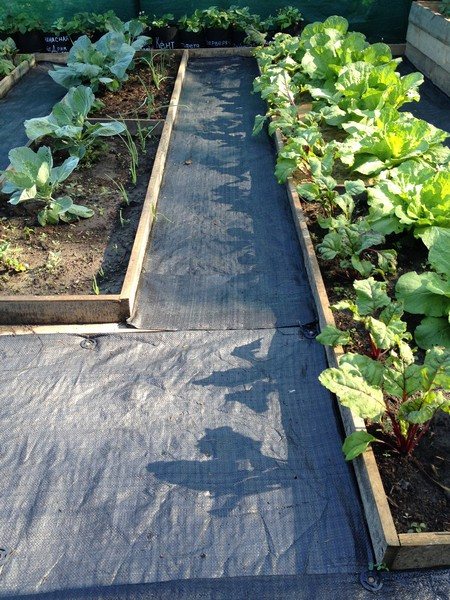

Manufacturers and retail price
The leading brands of nonwovens for agriculture are Lutrasil (Freudenberg, Germany), Agril (Avintiv, France), Agrotex (GK Hexa, Russia), Agrin (Unispan, Ukraine) and Plant-Protex (Poland). On the Russian market, you can buy spunbond of any manufacturer from official representatives and regional managers or in gardening stores.
For farms, the covering material is sold in rolls of 100 m or more, the most popular width is 160 or 320 cm. When ordering products, the dimensions may vary. For the needs of summer residents, manufacturers produce a canvas with a length of 10 m.
On the Internet, you can find specialized stores offering spunbond at manufacturer's price, while additional discounts are attached to wholesale. However, even retail will be quite acceptable for a private country house. The formation of the price per meter is influenced by the density of the material and the type of spunbond.
For wholesalers, the average price of spunbond with a density of up to 42 g / m2 is 3-6 rubles / m2, a density of 60-80 g / m2 will cost 7-12 rubles / m2. The average retail price (for 2020) for a pack of 10 m of canvas will be from 170 (width 320 cm, density 17 g / m2) to 550 rubles. (width 320 cm, density 60 g / m2).
Agrotechnics
Recently, there has been an increasing demand for agricultural fabrics, gardeners are attracted by the possibility of protecting crops from weeds. In addition, the technology of manufacturing such fabrics excludes the use of herbicides, making the harvest more environmentally friendly. This fabric is very convenient for placing plants on the ridge.
Agro-fabric can be used not only for weed control, but also in greenhouses and greenhouses. Moisture is retained in the soil longer due to the retention of evaporation by the fabric. In addition, an optimal temperature regime for the plant is created.
Agrotechnical fabric, like non-woven fabric, is UV stabilized. Its color can be either white or black; even green and gray ones are made to order. White agro-fabric protects the plant from overheating and prevents UV rays from affecting the soil. Constantly in contact with water, agrotextile does not start to rot, it can regularly serve for about 5 years.
The labeling of agro-fabrics depends on whether the fabric is striped or in a cage. To better understand the labeling of agro-fabrics, I give the following table:
Agrotechnical labeling
On our website, you can choose a covering material in accordance with your needs. Choose in the section
Lutrasil
Is a modern synthetic non-woven material made of polypropylene fiber, which is designed to protect plants in difficult weather conditions (frost, fog, etc.).Lutrasil is available in two versions: black or white and can be of different thickness.
Lutrasil - covering nonwoven fabric - is produced in Germany. It doesn't get wet. Its light transmission is higher than that of polyethylene film. There are different densities.
Lutrasil is presented in the following groups, depending on the density - light, medium canvases and denser models to ensure plant protection in winter.
The thinnest "Lutrasil Termoselect"
(17 g per 1 g / m2) protects plants from frost down to -2 ° C. Light transmission - 92%. The white canvas freely transmits ultraviolet rays. Plants can be watered without removing the shelter.
Denser white "Lutrasil Frostselect"
(30 g per 1 g / m2) reliably protects plants from hail, frost down to -60 C and birds. It is used for heat-loving crops (cucumber, pumpkin, squash, squash, pepper). I successfully use Lutrasil with a density of 42 g / m2 and 60 g / m2! and for covering greenhouses.
Lutrasil (60 UV) - a black cloth, elastic and light, inhibits the growth of weeds, creates a favorable regime for plant roots. It is spread over the surface of the ridges as tightly as possible, securing the edges.
Spunbond: what is it, the use of a covering material in gardening
About 10 years ago, I learned about a fundamentally new covering material for vegetable crops grown on six acres. The innovative spandbond protects the plants while allowing water to pass through. That's all I knew about him. When purchasing, did not attach importance to density, used it ineffectively. Only after a while I learned the advantages of the canvas.
Now I am ready to tell you what spunbond is and how to use it on a personal plot. After all, manufacturers are improving technology and improving the performance of the material, while reducing the price per running meter.
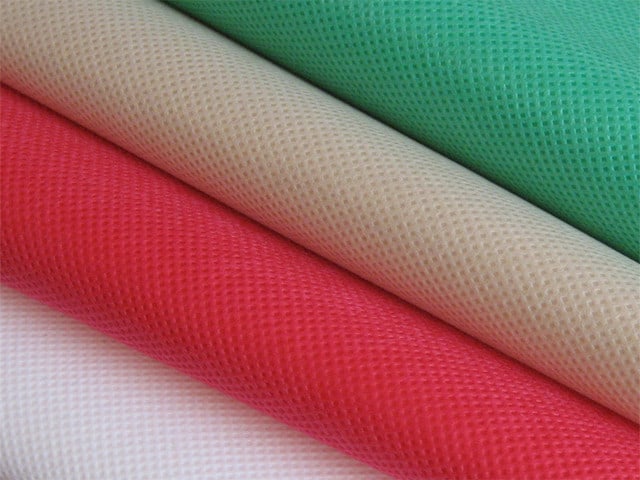

Testimonials
I bought a black covering material in the summer and planted a strawberry bed 10 meters long and 3.2 m wide (I barely found one in Krasnodar). The material turned out to be quite dense, but what was the name, I forgot, lutrasil, or something, but its price is 37 rubles. per running meter (3 m 20 cm width). I liked my garden very much. This spring, I want to plant tomatoes, peppers, eggplants, zucchini and cucumbers under the same fabric this spring, so that I can spend less time fighting weeds and less water for watering. I saw rolls on sale in bulk (200 meters) at a price of 2600 rubles per roll (the width seems to be the same, I did not ask for the thickness), i.e. the cost of one running meter is much cheaper than 13 rubles or 37 rubles, the difference is significant.
IrinaK
I cover the strawberries with a spandbond so that they bloom early and the berry was earlier. Spandbond is light, like a spider web, and allows air and moisture to pass through, unlike film. But it retains heat less. Plus, it is light, and plants raise it themselves during growth. There is a black non-woven fabric with a denser texture. It is good for them to cover the ground, make cuts and plant plants there.
Dream herb
... Personally, my experience of mulching with black lutrasil is unsuccessful: it is impossible to spill the soil under it and, most importantly, anthills start, and weeds crawl out exactly from the holes cut for planting, and you have to rip out dandelions and thistles right from the cultivated bush. But, in principle, if the areas are large and only shrubs are supposed to be planted, it probably makes sense in the lutrasil bedding. And for watering and fertilizing, you can dug in bottles with a cut-off bottom under the bushes, and for the drainage of rainwater, poke a few holes in the lutrasil (the new black lutrasil behaves like a film - it repels water). Under organic mulch without bedding, the soil breathes better and its structure improves, but then, in order to crush the weeds, the mulch must be poured in a very thick layer and no more digging there, otherwise the bark will mix with the soil and the weeds will be sown again.
imers
Lutrasil and spunbond are popular synthetic covering materials that are durable and strong. They do not have any special differences, therefore, when choosing, one should proceed from the presence of agrotextiles of the required density and try not to overpay.
A little about the manufacture of spunbond
In the 21st century, scientists have given rise to a new technology in the field of polymers. The synthetic substance melt passes through special filters in the form of threads. They form the web on the conveyor. After the material is processed so that it becomes marketable and wrapped in rolls.
The spinning method of manufacturing allows you to obtain a dense nonwoven fabric with amazing properties:
- low crease;
- frost resistance;
- durability;
- heat resistance;
- durability.
In addition to the use of canvas for the manufacture of disposable clothing in medicine, farmers saw great opportunities for use in spunbond.
Enterprises produce canvas with various characteristics. For use in agriculture, a density of 17 to 60-80 g / m2 is suitable. Such a covering material is good for use in open and protected ground.


How spunbond differs from lutrasil
With the onset of the new season, most summer residents are concerned about the issue of spring frosts. They can be bad for young plants. To avoid this, it is necessary to create an optimal microclimate for them. It will promote the active development of plants, and this will bring a bountiful harvest.
The necessary microclimate will help to create various covering materials specially designed for this purpose. In recent years, many of their species have appeared, and most of them are of artificial origin. Agrospan is one of the newest covering materials. According to the farmers, it has excellent characteristics, and what exactly we learn from the article.
Covering material properties
Using the material in a garden located in the Moscow region, I draw attention to the characteristics of the canvas:
- the material keeps heat, preventing cold air currents from penetrating through it;
- increased air permeability in the created space;
- the canvas has uniformity over the entire surface - this allows you to create a microclimate inside a closed space: the necessary humidity and temperature;
- light passes through the material;
- the light weight of the material allows you to cover young seedlings of crops without exerting pressure, and therefore, without causing harm;
- the strength of the material allows it to be crumpled, washed;
- resistant to low and high temperatures;
- the surface of the canvas is resistant to harmful microorganisms, causing fungi and bacteria to die;
- pesticides and other compounds will not harm the material;
- the material does not emit harmful substances into the atmosphere - it belongs to environmentally friendly products.
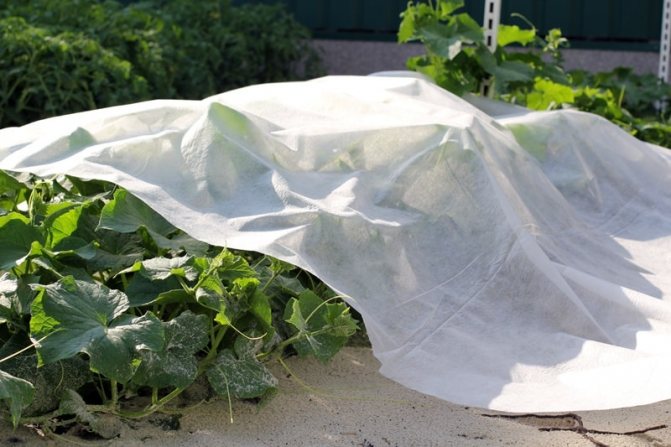

Which side to put the spunbond on the ground
At the beginning, using spunbond did not attach importance to which side to cover crops. Then I stumbled upon a discussion of Internet users. On one of the forums dedicated to gardening, summer residents shared their experience.
It turns out that some manufacturers write on the label where the top and inner sides of the web are. But most types of spunbond are produced without explanation.
Any side of the covering material allows water to pass through, but smooth - to a lesser extent, pimpled - to a greater extent.
When constructing a greenhouse, spunbond retains all properties, including thermal insulation, but it is better to have a pimpled surface on the outside, and smooth on the inside.
A video will be a good help before buying and using a spunbond. It tells how to strengthen the covering material in the garden:
Quality of non-woven fabric
The first is the presence of a stabilizer for ultraviolet radiation and the second is uniformity in density or, simply put, the absence of bald spots.Unfortunately, it is impossible to determine the presence of the stabilizer by eye, therefore it is better to purchase covering products from those companies that protect their products from counterfeiting with special signs. So, for example, a green or blue stripe is applied to the spunbond.
For southerners and young northerners. Shelter is needed not only thermophilic, but also young and recently transplanted ornamental trees and shrubs, including the beloved roses.
It is not necessary to rush to take it off in the spring: it lets through, as mentioned above, both light and moisture. The approximate price of 1 m2 of agrotex grade 17 is 2.90 rubles, 30 is 4.20 rubles, 42 is 5.80 rubles, agrospan grade 17 is 4.40 rubles, 30 is 7.70 rubles, 42 is 10, 80 rubles, 60 - 15.40 rubles.
In the spring, every summer resident has a new reason for worries - the purchase of a suitable covering material that would provide the crops and young plants with an optimal temperature regime.
In the market of auxiliary agricultural materials, this category of products is represented by a wide variety. The leaders among non-woven varieties are Lutrasil and Spunbond.
How to use spunbond in gardening
In the spring
To quickly warm up the ground, it is enough to put the canvas on snow or soil. Heat is generated under the material and the surface of the earth, which is transferred to the soil.
When the ground warms up, I don't move the spunbond far away. I plant radishes, lettuce in the greenhouse, covering the seedlings with an additional blanket.
Then comes the turn of zucchini, cucumbers, pumpkins. Heat-loving crops under cover start growing faster. And if there is a danger of freezing, and the temperature at night is approaching zero, then in the greenhouse and under the spunbond the plants do not feel the cold.
I wrap dahlia bushes and other flowers that are afraid of night frosts in small pieces of material. When the temperature drops, even a shelter on top of plants can play a big role - spunbond will not let the cold air flow through, retaining heat.
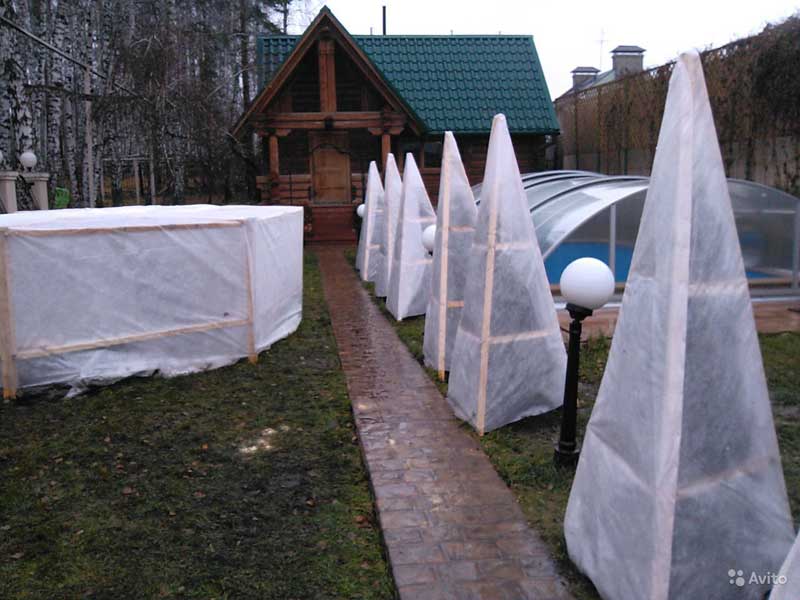

In summer
I grow sweet peppers in a large greenhouse, and from spunbond I build a small greenhouse, where bitter peppers yield. In the heat, I raise the material to the side for ventilation.
- The canvas perfectly transmits light.
- Demonstrates excellent thermal insulation.
- I water from the side, and also from above directly onto the material. By watering, I lightly press down in the right place so that it is there that water falls on the bush and the ground.
Black spunbond is used for mulching the soil of strawberries and strawberries and protecting it from various birds and pests: rodents, slugs, bear.
And also weeds do not grow under the shelter and there are practically no erosion processes that occur during strong windy weather. In the heat, the root system does not overheat, but in the cold it is warmed up due to the covering material.
Important! Spunbond allows water to pass through during irrigation or rains, but evaporation of moisture from the surface of the earth is greatly slowed down.
I also use the canvas for mulching gooseberry and currant bushes. Previously, branches with berries were in contact with the ground. In humid weather, there was a danger of infection with gray rot, then with the use of spunbond, the probability of infection decreased significantly.


In autumn
I do not remove spunbond. The canvas plays the role of a reliable shelter when the first frost occurs in October in the absence of snow cover. Perennial plants with such protection more easily go into the stage of deep dormancy.
In winter
During the winter months, including March, when spring is slow to take over, spunbond continues to protect crops. "Spunbond blanket" warms young seedlings of fruit trees and shrubs during cold weather, weakens the effect of temperature changes.
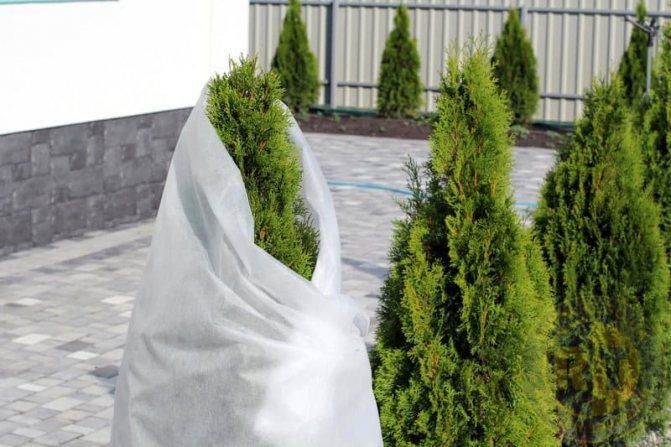

Density of non-woven polypropylene fiber
- 17-30 g /m² - a material with such a density range would be just right for my purposes. It is able to protect plants in open ground from strong sun and short spring frosts at night, and due to good air, water, light permeability and good thermal conductivity, it helps to organize a special microclimate for plants for the best growth and development. The advantage of this material is also protection from birds and insects. Shrubs, berries, vegetables, fruits and ornamental plants, mainly growing in open soil, are covered with a material with a density of 17-30 g / m².
Varieties of covering material
Gardeners sometimes face a difficult choice of covering material. It can be white, black, two-color. The material differs in different density and price.
In recent years, a two-layer material has appeared on the market. There were also new colors with various combinations: black and white, black and yellow, white and red.
- The yellow side repels insects.
- Red accumulates additional heat.
- The black side of the material prevents weeds from growing and is used as mulch.
Another novelty of recent years is spunbond foil with stripes. The silvery surface improves the illumination of the plants through reflection.
Photosynthesis is activated, cultures develop faster. In addition to the silver-black type of spunbond, a silvery-white material is produced that improves the growth of green wards, additionally protects against freezing.
Which side to lay the white agrofiber. Alternative to weeding
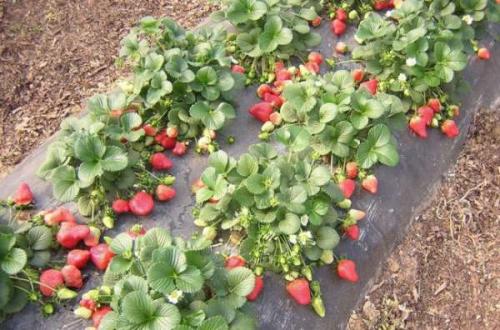

It is more pleasant to care for strawberries growing on a covering material, and the berries do not get dirty from the ground.
Weeding a strawberry plantation is a time consuming job, and you have to do it several times per season. A convenient solution to this problem has been found: the surface of the land in the garden bed is lined with special materials that suppress the growth of weeds. At the same time, compact strawberry bushes continue their normal development.


When watering, the soil fell on the strawberry fruits, if mulching had been used, this would not have happened!
What and how to cover the soil? The best material is black agrofibre. In addition, black plastic wrap, roofing felt, roofing felt, newspapers and pieces of cardboard, a thick layer of straw or other mulch are used for the same purposes.
English version (organic mulch)
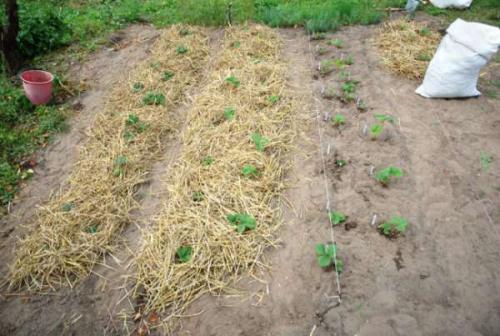

Organic mulch needs to be renewed once or twice a season.
It is known that the British call strawberries "straw berries" because they put straw under the bushes so that the berries do not get dirty from the ground.
Instead of straw, you can use pine needles, wood chips, pieces of bark and other organic materials. Fresh mulch partially inhibits the development of weeds, but for this its thickness must be at least 8 cm, with annual renewal.
Weed seeds, falling on loose mulch, still germinate. Cardboard or newspapers have a denser structure, but they quickly get wet and lose their properties. All these improvised means do not guarantee complete protection of the beds from weeds.
Finnish experience (black polyethylene)
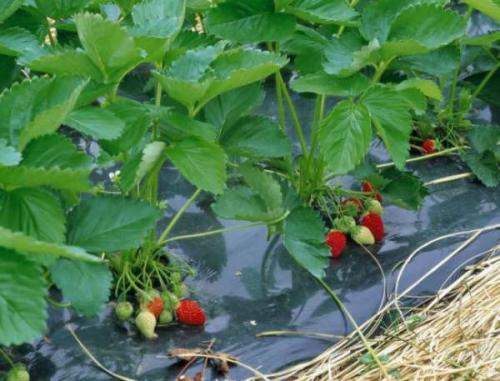

Mulching strawberries with foil is not the best option due to certain disadvantages.
Before the advent and active spread of agrofibre, they came up with a technology for preliminary covering strawberry beds with black plastic wrap (or tar paper, roofing felt).
At the same time, young rosettes are planted in small cruciform incisions. This method has shown good results in a northern country like Finland. In Russia, it is still used by some gardeners.
Disadvantages of Finnish technology:
- the film must be of high quality and expensive, otherwise it quickly bursts, collapses;
- the soil does not breathe;
- strawberry roots overheat, rot (hot, condensation);
- it is advisable to lay a drip irrigation system under the film.
Positive aspects:
- no weeds;
- the mustache does not grow, it is convenient to remove them;
- pests (such as weevils) have nowhere to winter;
- the berry is clean (no dirt and rot);
- it is convenient to harvest the crop;
- heat is accumulated and fruiting is accelerated.
Black agrofibre
Agrofibre (non-woven covering material) of black color is very convenient to use for mulching the soil. It has all the positive properties of a mulch film, without its disadvantages.
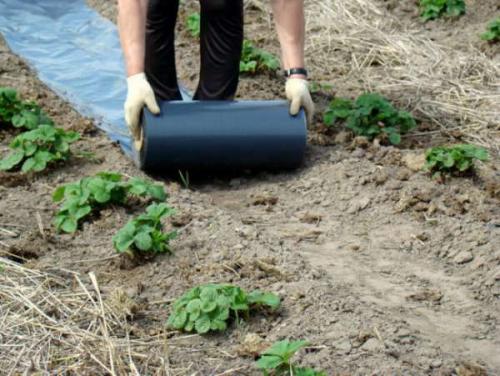

It is convenient to work with a covering non-woven material and it serves for a long time.
Weed control mulching fabric has additional valuable qualities:
- The fabric lays down softly, without creases. Easy to cut and sew to any size.Mechanical damage can be sewn up or patched.
- The material is synthetic, so it does not rot. Does not deteriorate under the influence of sunlight, lasts for several years.
- The porous structure allows the strawberry roots and the soil layer to breathe freely, where beneficial microorganisms and earthworms are actively working.
- Water flows freely downward during rain and irrigation.
- Evaporation from the bed surface is reduced.
- It is convenient to work with the material. It is pleasant to look after the beds. Time is saved.
- Agrofibre is quite affordable.
A very comfortable environment is created for strawberry plants.
Varieties of black covering material
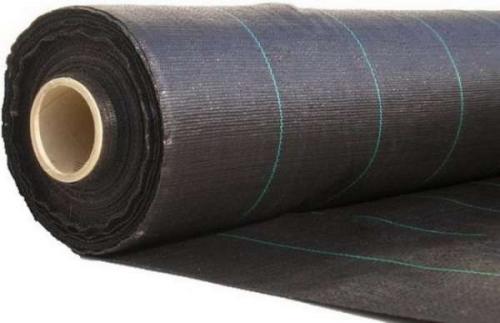

All covering materials are united by the ability to pass moisture and air.
Agrofibre from various manufacturers is produced using a similar technology. Names may differ for different brands:
The thickest and most durable material is No. 60 (this is an indicator of high density).
In recent years, a two-layer version (white-black or yellow-black Agrotex) has become widespread. The lower black side prevents weeds from growing, and the upper light side protects the roots and the aerial part of the bush from overheating. Two-layer Agrotex is convenient to use on hot southern slopes, in greenhouses and greenhouses, in southern regions.


The outer white layer of Agrotex saves from overheating, and the inner black layer absorbs sunlight and keeps weeds.
What is Spunbond and its features
The technology that allows to make nonwoven fabric of appropriate quality, specific properties and cost - this is Spunbond. Its main features are:
- high strength;
- environmental friendliness of the material;
- affordable price;
- ease of use;
- air and moisture transmission;
- leveling of deformation due to temperature changes.
The density of matter can be different: from 17 to 60 g per m2. Both durability and cost directly depend on this. Black spanboards are used for mulching. Products are produced using this technology, both in our country and around the world.
Characteristics of the covering material for covering plants
What is the difference between different types of coatings, and which one should be used in a particular case? These names reflect production technology and are trademarks of non-woven polypropylene fiber. One of the most significant differences is the density of such a material, which determines the intended purpose. Knowing it, you can quickly and correctly determine the choice according to the type of product. There are 3 groups according to such a criterion as the density of the covering material:
- from 17 to 30 g per m2 ... Coating functionality: protection from scorching sunlight, night frosts in the spring, the formation of an optimal microclimate due to the permeability of air, moisture and light, as well as heat-conducting characteristics. Shelter from insects and birds of plants grown in open space. Application: bushes, berries, vegetables and fruits.
- from 42 to 60 g per m2. It is used as a covering material for greenhouses and hotbeds.
- more than 60 g per m2 ... For what - a shelter from excessive sunlight, cold weather and herbicide-free preventive measures against weeds. It comes in black and white. The first is also a mulching agent. And the second is an excellent frame for a greenhouse. The most expensive covering material for the garden and vegetable garden, but has a number of advantages: durability, UV stabilizers. It allows moisture to pass through, so there are even fewer problems in the care of the beds.
The name spunbond is usually heard as a general term for all types of covering materials. This type of product has excellent performance that has made it a favorite in the market.
Types of spunbond and their characteristics
In garden centers, you can find several options for spunbond, consider the most popular ones:
- Lutraxil.Very thin and light (density - from 17 g / m²).It is able to protect from frost, is elastic, and can be used to create greenhouses. Available in black color, it is impenetrable to sunlight. Lutraxil Photos
Protects against the growth of weeds, serves as a mulch. Designed for covering paths, aisles, plantings. Usually used for strawberries, onions, tomatoes, cucumbers. Before planting the plants, holes are made in the lutraxil, then they will be used for watering. Agril. It has a high level of permeability, so the sun's rays warm up the plants under the shelter well. Photo of white Agrila
Agryl perfectly permeates moisture, air, is easy to use, does not allow the formation of a crust on the ground, erosion. Density - 40, 17 (white) and 50 g / m² (black).
- Agrospan. Differs in a long service life, guarantees maintenance of optimal gas exchange, prevents hypothermia and overheating of plants. The conditions created under the shelter prolong the life of crops, which allows harvesting practically before the onset of severe frosts.
- Agrosuf. They are used to protect greenhouses when growing berries, flowers, shrubs. The crops are planted directly into the ground, after which they are covered with a film. It keeps plants from ultraviolet rays, a sharp drop in air temperature. Sometimes Agrosuf is also called "frameless greenhouse". The polypropylene canvas does an excellent job of creating an optimal microclimate for the crops grown.
Spantex canvases are usually used in the construction of greenhouses, since they protect the structure well from external and weather factors. They are distinguished by high thermal insulation properties, long service life.
Features of covering cloths
Lutrasil is a new generation covering material that has found its application in vegetable gardens and orchards. In addition, it has a number of useful properties and has several modifications. Lutrasil is made on the basis of threads that are intertwined with each other into a single fabric. In the chemical industry, the technology for the production of threads based on polymeric materials, which are interconnected in several ways, is in wide demand:
- Physical (needle-punched connection method).
- Due to a certain temperature regime.
- Combined chemical methods.
Separately, it should be taken into account that chemical fibers can also be involved in production:
- Polyester.
- Viscose.
- Polyacrylonitrile.
- Polypropylene.
- Polyamide.
Due to the specific connection, these materials are usually called non-woven. But, despite this, such covering materials are made on the basis of natural raw materials, such as:
- Cotton.
- Linen.
- Wool.
Multifunctional nonwovens, which were made on the basis of chemical fibers, are widely demanded in various fields, including growing fruits and vegetables in the garden, as well as in horticulture. Experienced summer residents often call this material agrotextile.
Once again about polyethylene.
But the closest material for amateur gardeners has been plastic wrap for many decades. Its strength and durability also depends on density, but there are other parameters that you need to pay attention to when choosing:
Reinforced polyethylene film
The simplest type of film is the one that is used for growing crops mechanically. It can be black or black and white three-layer material, which must be permanently removed for watering and aerating the soil. Thickness indicators are almost identical - 6-7 mm. For strawberries, cucumbers, you need a special bedding. It can be either very thin or more massive.
Application for soil mulching
Black lutrasil is often used for mulching plantings, paths and row spacings. The garden bed, which is prepared for planting a plant in spring, needs to be covered with black lutrasil and cuts are made. The following crops are planted in them:
- tomatoes;
- cucumbers;
- strawberries;
- bow and much more.
Plants are also watered through these incisions. Lutrasil does not collect condensation, does not allow the formation of excessive moisture, does not contribute to the appearance of mold, and the earth ultimately remains loose. Also on sale you can find a two-color material for mulching soil, the upper part of which has a white tint, due to which the root system will not get very hot... Also, strips of lutrasil are placed under the main coating when laying decorative paths on the site. On average, the service life of such a covering material for mulching is about three years.
Polycarbonate as an option for a modern greenhouse
In addition to the film with arcs, you can build a more durable frame for growing plants - made of polycarbonate. Its advantages are reliable protection from wind, sun, precipitation, birds and animals. It does not let the soil surface infestation by weed seeds, but the optimum temperature is excellent.
Polycarbonate greenhouse
Polycarbonate sheets are light and durable, flexible and practically do not burn. According to the structure of the sheet, which determines its strength, there are three main types:
- single chamber in 4, 6, 8 or 10 mm thickness;
- two-chamber 16 mm;
- reinforced in 4 and 6 mm;
- four-chamber 25 mm.
The color spectrum is also different and affects the light transmittance of the material.
Polycarbonate
It is difficult to imagine a modern greenhouse without polycarbonate; it is one of the most reliable shelters for plants and creating all conditions for their growth and development. This material is not afraid of rain, wind, or bacteria, it is durable, lightweight, keeps heat well and transmits light.
Cellular polycarbonate. Photo from the site
What is so remarkable about cellular polycarbonate for greenhouses? In fact, polycarbonate is a sheet of plastic with cavities inside, something like "honeycomb". It is lighter than monolithic, odorless. The sheets are strong, but at the same time light enough. For example, glass weighs 16 times more, and acrylic 3 times more than a sheet of cellular polycarbonate.
Cellular polycarbonate is nonflammable, but it has excellent ductility. Transparent polycarbonate is capable of transmitting up to 92% of the sun's rays. In the manufacture of polycarbonate sheets, a UV stabilizer can also be added to them, which increases the service life of this material. The polycarbonate greenhouse is very durable and easy to assemble The structure of polycarbonate honeycomb and the thickness of the sheet affect the area of its application. To better understand the thickness of polycarbonate of different structures, a table of indicators is given below.
Indicators of polycarbonate
The produced polycarbonate sheets have standard dimensions of 2.1x2 m, 2.1x6 m and 2.1x12 m.The thickness is different, it can be from 3.2 mm to 3.2 cm. The produced cellular polycarbonate can be of various colors. When choosing such a material, it should be remembered that the more complex its internal structure, the more reliably it protects from snow and wind.
A greenhouse made of this material is very durable and easy to assemble. How to make a polycarbonate greenhouse with your own hands, you can see in the article DIY polycarbonate greenhouse.
Polycarbonate greenhouse
What covering material for the garden and vegetable garden is better?
It all depends on the specific goal. It is more profitable to use the film for greenhouses, as it allows heat to pass through. But it will have to be removed for watering and airing the soil. And you can cover the seedlings with a spanboard without fear that the rain will lead to the sagging of the matter and break the plants under it.
Spunbonds are effective in protecting horticultural crops from frost and precipitation.
However, spanboard frame structures will be expensive, as high density material will be required. Smart gardeners use both of these materials. In early spring - a film, and in the warm season - a spanboard or similar products.
Alternative to well-known materials
Agro-fabric as a covering material for a garden and vegetable garden has become widespread due to the protection of beds from weeds, ease of use for mulching the soil, and durability. But its main task is to preserve moisture, air access, and prevent overdrying of the soil. It is also suitable for greenhouses, but only as a surface ground material.
Preservation of ornamental bushes
Initially, it is important to note the fact that roses tolerate night frosts well down to -8˚С. But if the frosts began to intensify, then in November it is necessary to take up the planned shelter of plants and not forget to clear the bushes of unnecessary leaves. It is best to use high density canvases. Only in this case can you be sure that the plants will be able to overwinter.
Another, no less important point is that the larger the insulated area, the warmer the bushes will be. Experts point out that it is necessary to cover at least 1 m², but it is better to expand this area. Thanks to this, the earth will be able to give off more heat, and the roses will be able to withstand even the highest frosts.
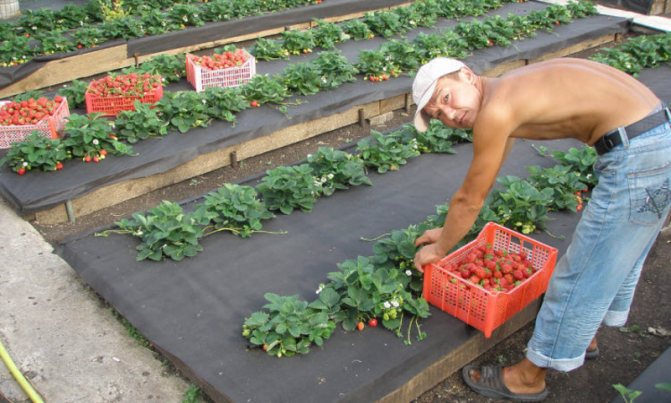

If the roses are curly, then they need to be carefully tied into small bunches, and only after that they should be bent to the ground. Beforehand, it is advisable to put something on the soil, for example, small logs or boards. This will help prevent the branches from getting wet and rotting when the thaw sets in. Today there are some hybrids of roses that are simply impossible to bend, so it is better to prune them a little (they should be at least 50 cm from the ground). In specialized gardens and nurseries, lutrasil is placed on special props and arcs so that the canvas does not sag under the snow and does not press on the plants.

